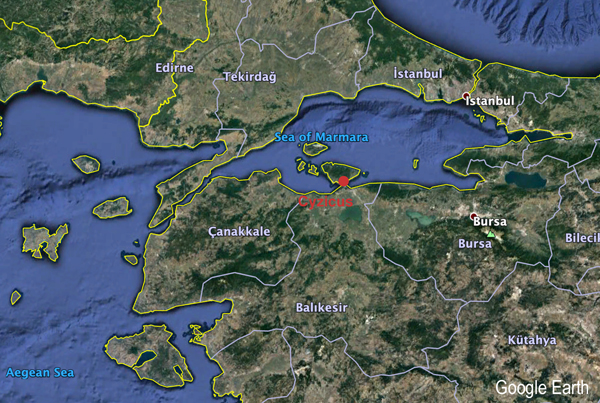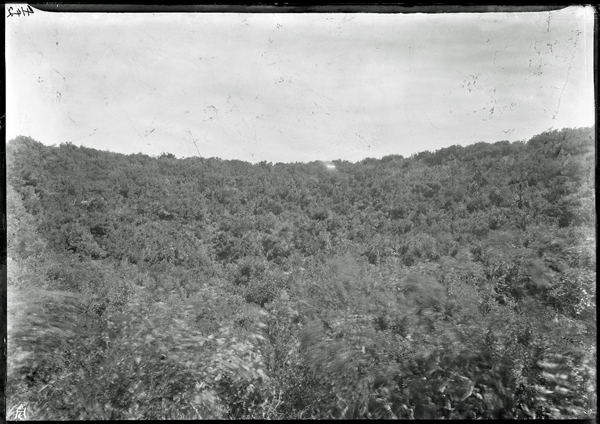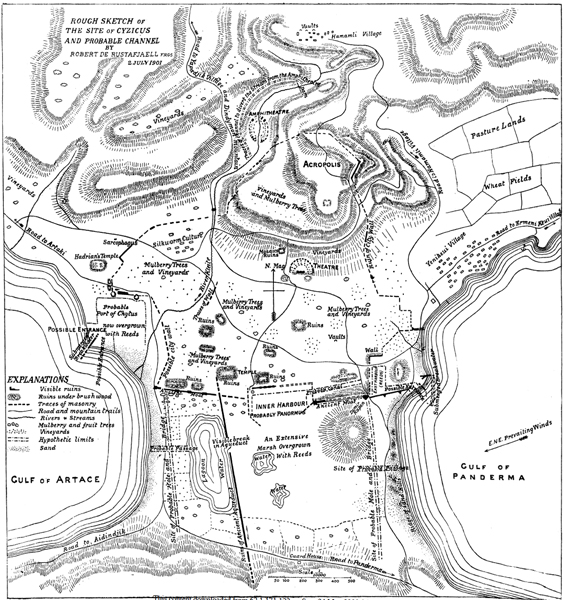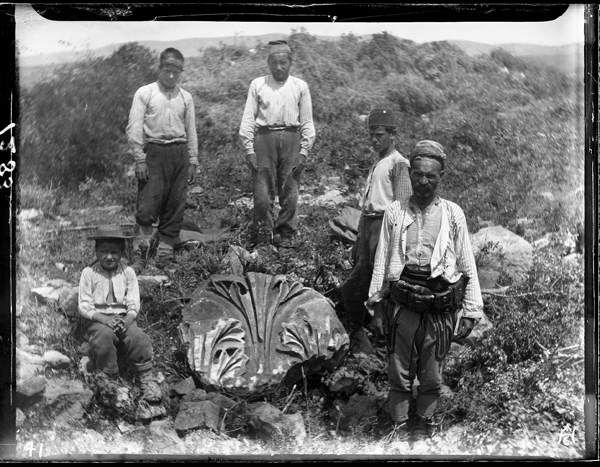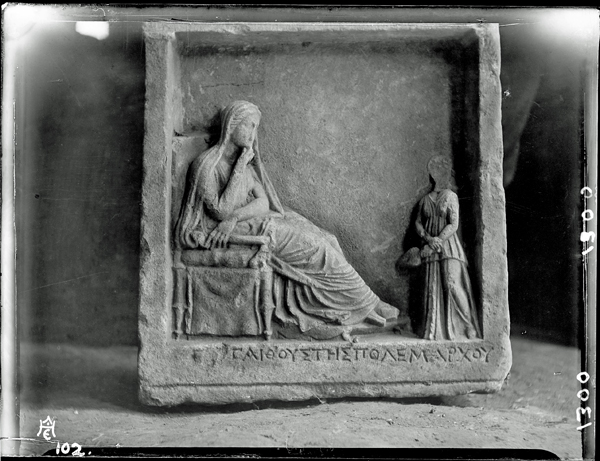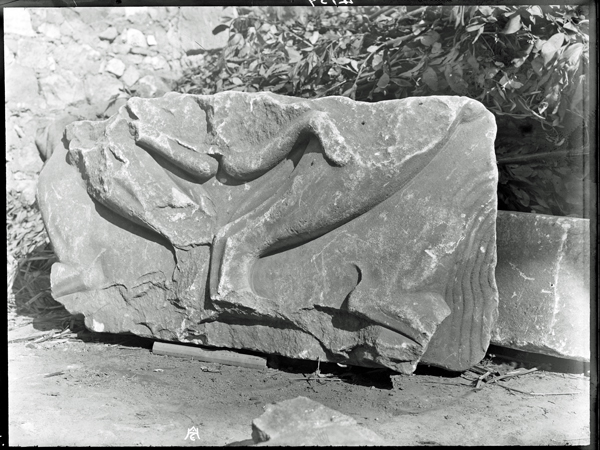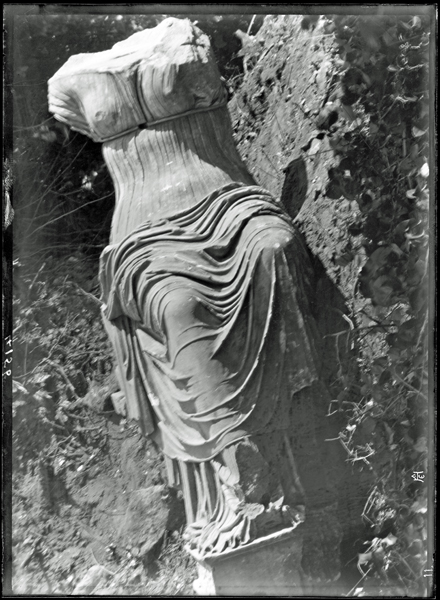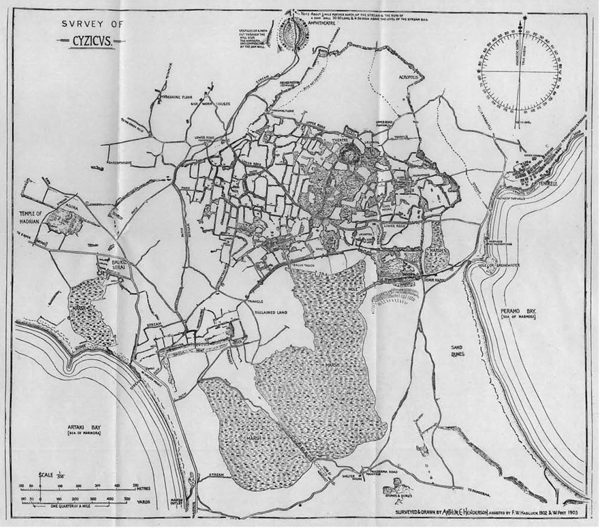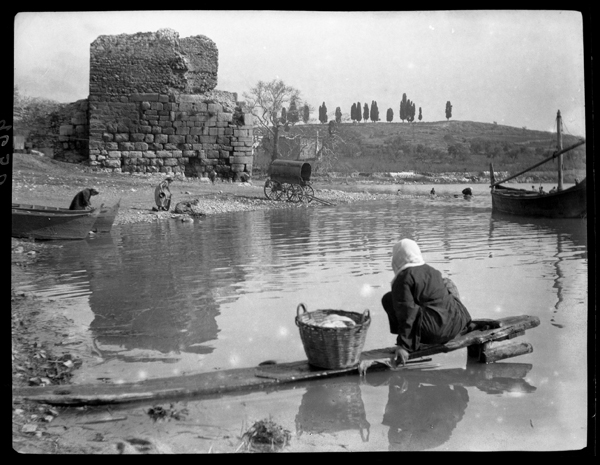The Cyzicus Question: Hasluck, Henderson and the SPHS Image Collection
In November 1901 Frederick W. Hasluck arrived in Athens to take up a recently awarded studentship at the British School at Athens (BSA). He arrived at a time when the BSA had just been presented with the possibility of conducting fieldwork at the major Archaic to Medieval city of Cyzicus. It was a significant site to excavate as the city featured in numerous historical battles given its strategic location in the Balıkesir district of Anatolia in the middle of the Sea of Marmara, commanding routes between Istanbul and the Dardanelles. The site itself is situated at the neck of the Kapıdağ Peninsula.
Cyzicus was a favoured destination for travellers and antiquarians as well as a target for illicit digging and looting. Former BSA Student, J.A.R. Munro, who visited the site in 1894, remarked on the state of preservation:
The site of Cyzicus, known to the Turks as Balkus (Παλαία Κύζικος?), has been for so many centuries a quarry for building-stone that little is now standing above ground. The level ground is one big garden of vines and fruit-trees – olives, walnuts, peaches, and cherries. The bay tree grows wild in such profusion that the air is scented with its perfume. Inscribed or carved stones, plundered from the site, are to be found in most of the neighbouring villages. [Munro and Anthony 1897: 158]
According to Hasluck’s later publication summarising previous work done on the site, some ‘recent’ excavations had taken place, but none were ‘worthy of the name’ and were abandoned shortly after they began. Frank Calvert, known for his exploratory excavations at the mound of Hisarlık, excavated tombs. Although Calvert’s work here was not published at the time, Hasluck incorporates Calvert’s notes in his final publication of 1910. Calvert was followed in 1876 by Titus (‘Tito’) Carabella, an Italian diplomat and archaeologist who lived in Constantinople. Carabella opened a few trial trenches on the acropolis, published in the form of a letter in Revue Archéologique the same year. Next, the site was haphazardly excavated in 1901 by Robert de Rustafjaell, an eccentric British collector, excavator, mining engineer and geologist. He was known by various names (Robert Smed or Smith, Robert Fawcus-Smith and Col. Prince Roman Orbeliani) and noted for his later work in Egypt: as an author of Egyptian subjects and his questionable role as collector and dealer in antiquities as well as fakes. It was de Rustafjaell who brought Cyzicus to the attention of the BSA.
In his own account, de Rustafjaell mentioned that he paid a ‘cursory visit’ to Cyzicus in 1900, consulted with Carabella, then requested and received permission (a firman) from the Turkish authorities to excavate in the spring of 1901. He published his impressions of the site in the 1902 Journal of Hellenic Studies (JHS) that included a hand-drawn plan roughly placing the location of ruins among current agricultural activities and a few photographs, but no specific details about the actual excavations. Cecil Smith of the British Museum and former Director of the BSA who was acquainted with de Rustafjaell, studied inscriptions based on de Rustafjaell’s notes and published them in the same volume of the JHS as de Rustafjaell’s article.
In December 1901, a month after Hasluck arrived at the BSA, he and the Director, R.C. Bosanquet, visited Cyzicus at the invitation of de Rustafjaell. During their visit, Bosanquet and Hasluck had been allowed to take squeezes of inscriptions (including two new ones), providing Hasluck with plentiful material to work on back in Athens which he published in the 1901-1902 Annual of the British School at Athens (ABSA). It was arranged at that point that Hasluck would travel to Constantinople the following March to consult with the BSA architect, Arthur E. Henderson, and, with Henderson’s assistance, to begin fieldwork at Cyzicus in spring of 1902.
On the 7th of December 1901, R.C. Bosanquet wrote about his and Hasluck’s first impressions of the site:
And Hasluck and I took the village watchman, a Tcherkess from the Caucasus, who patrols the fields armed with an old musket, and went to the amphitheatre, a most beautiful spot outside the walls. A stream has burst through the mighty fence and careers through the arena; a great part of the walls has fallen; but great piles of masonry still tower to heaven, and the hillsides are full of overgrown vaults; the whole hollow is a mass of luxuriant thickets, bay, arbutus, ivy and honeysuckle; sprays of unripe blackberries hang over the water. [Bosanquet 1938: 98]
Although a survey had originally been intended as a preliminary study in preparation for excavation, the BSA soon abandoned the notion of excavation by early 1902. The Annual Report in the ABSA for 1901-1902, simply states that the BSA’s Managing Committee took the decision not to excavate. The story behind this decision predates Bosanquet’s and Hasluck’s visit to the site in December 1901. Sources in the BSA Corporate Archives indicate that de Rustafjaell first contacted the BSA Managing Committee in March 1901 – just after he received the firman and prior to his excavation – to request both funds and advice. In a letter to Bosanquet dated 26 March 1901, the Chairman of the Committee, George Macmillan, indicated that de Rustafjaell’s ‘knowledge of archaeology, being as he admits, by no means on par with his enthusiasm’ and stated that it was in the BSA’s interest to ‘prevent a good thing being muddled away by unscientific handling’. It is also clear in another letter a few weeks later on 12 April from the Chairman to the BSA Treasurer, Walter Leaf, that the BSA had no intention of funding the project. However, they had hoped that de Rustafjaell would be able to interest Herbert Weld-Blundell, a philanthropist with an interest in archaeology whose proposed project to excavate at Cyrene had just fallen through. George Macmillan and Cecil Smith put de Rustafjaell in touch with Weld-Blundell, but it is unclear from these accounts if Weld-Blundell agreed to fund the project. It seems unlikely since no independent funding was forthcoming.
By October of 1901, after one season of excavation, de Rustafjaell sent his report to the BSA Committee who, in turn, strongly encouraged Bosanquet to meet him. In January 1902, the Committee received Bosanquet’s report on the December 1901 meeting with de Rustafjaell. It was then that they considered the terms of working with de Rustafjaell. They added a strict clause to the agreement concerning the exportation of antiquities as there was concern about de Rustafjaell’s initial purpose for excavating. Under no uncertain terms were antiquities to be exported without the express permission of the Turkish authorities. It was unclear whether de Rustafjaell would accept this condition.
Another dilemma cropped up at the end of January 1902 before de Rustafjaell responded to the BSA’s stipulations. Former BSA Director D.G. Hogarth – now Director of the Cretan Exploration Fund – offered Bosanquet the possibility of digging at Palaeokastro. The Committee was now faced with the difficult ‘Cyzicus question’ posed, on one hand, by de Rustafjaell’s uncertain acceptance of the strict clause amended to the agreement and, on the other hand, the opportunity to expand fieldwork in Crete where Bosanquet had already been working at Praisos.
A decision was taken early in February 1902 to excavate Palaeokastro. The site was strategic to BSA fieldwork goals in Crete and more secure financially. However, a compromise must have been reached with de Rustafjaell regarding Cyzicus. By March 1902 the Committee authorised Hasluck and Henderson to conduct a short-term survey at Cyzicus. They were to conduct the survey under specific conditions that prohibited excavation yet allowed for test trenches to help clarify evidence above ground. As the holder of the firman, de Rustafjaell, who was then in London, gave them permission to work at the site as well as the use of his equipment. Hasluck received £90 from the Craven fund and in April 1902 the survey of Cyzicus began.
Henderson, a former BSA student (admitted originally in 1897-98) as the Owen Jones Student of Royal Institute of British Architects and until his return to Britain in 1904 was listed as a BSA architect. By 1902, Henderson was residing in Constantinople where he was studying Byzantine architecture. Although Hasluck donated the negatives of photographs documenting the visible remains of Cyzicus to the Society for the Promotion of Hellenic Studies (SPHS), it was probably Henderson who was the photographer. Henderson’s photographs can be identified by his monogram sketched onto the negatives. In addition, many of the photographs include the figure of Hasluck for scale.
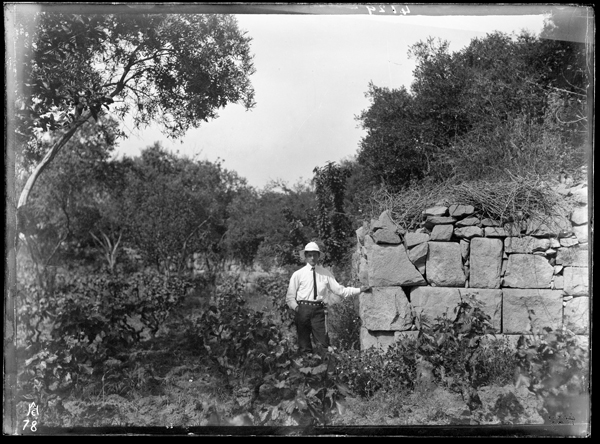
Caption: BSA SPHS 01/1654.4129. Cyzicus fortifications: E. wall and gate near Amphitheatre with F.W. Hasluck for scale
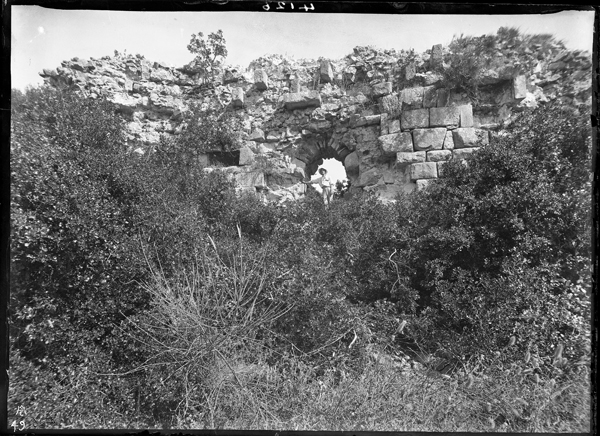
BSA SPHS 01/1651.4126. Cyzicus fortifications, N. wall and gate near Amphitheatre with the figure of F.W. Hasluck in gateway for scale
During that first year, Hasluck updated previous work recording inscriptions and studied early sculptures found during the course of the survey. These were promptly published in short articles in the JHS and the ABSA.
Henderson produced an accurate plan of the site in 1903, published in a joint article with Hasluck in the 1904 JHS and in his own 1904 article in Records of the Past. These articles provide a typology of construction methods, a useful list of Classical and historical sources for the topography of the site, and the detailed state plan produced by Henderson which precisely place the ruins. Meanwhile, Hasluck continued to explore the surrounding area from 1903 to 1906, covering some of the same ground as Munro and Anthony had done a decade before. It seems that de Rustafjaell must have lost interest in the site around this time as it is stated in his first of many publications on Egyptological subjects in 1906 (‘The Earliest Known Paintings on Cloth’) that he spent the previous summer in Egypt.
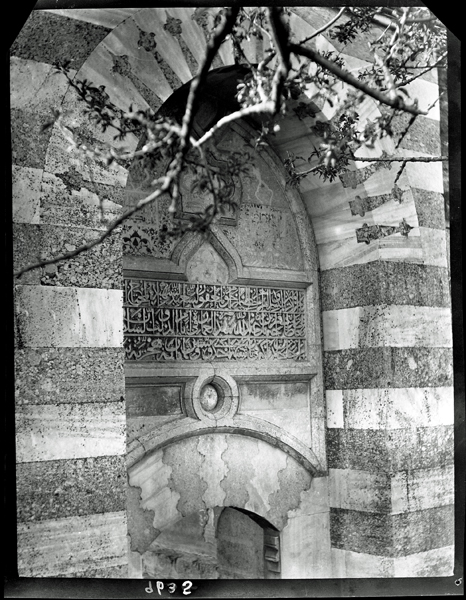
BSA SPHS 01/4689.9635. Imaret mosque (1465) in Muhalich (modern Karacabey), the inscription over the N. door
In 1906 Hasluck made a special investigation of the Roman Bridge on the Aesepus which he observed while travelling with R.M. Dawkins who had just succeeded Bosanquet as BSA Director. In addition, following the major Cyzicus project, Hasluck investigated the nearby Marmara islands in 1907 (published in JHS 1909).
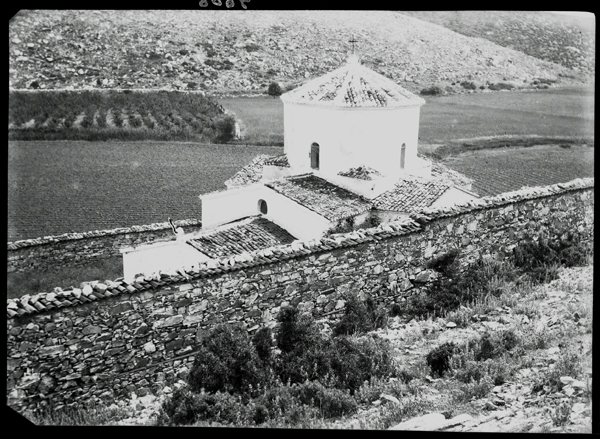
BSA SPHS 01/4862.9608. Marmara Island: Palatia (modern Saraylar), Agios Nicolaos ἐν τη Γέννα from the W.
The survey was the subject of Hasluck’s thesis which drew together the material he had published and added a detailed narrative to the history of the site and its territory. On the basis of this thesis, he was awarded a fellowship at King’s College Cambridge. He eventually published it with Cambridge University Press in 1910 as Cyzicus: Being Some Account of the History and Antiquities of that City, and the District Adjacent to it, with the Towns of Apollonia Ad Rhyndacum, Mietupolis, Hadrianutherae, Priapus, Zeleia, etc. The survey provided Hasluck not only with a thesis topic, but exposed him to a wide range of antiquities – from ancient to more recent. Although Hasluck deviated from the study of Classical archaeology after Cyzicus, his experiences between 1902-1907 inspired his enthusiasm for travel and laid the groundwork for his later interest in Latin monuments, folklore and religion, and the interaction between Christianity and Islam.
In 2003, much of the SPHS image collection came to the BSA including numerous images donated by Hasluck. Both Hasluck’s and Henderson’s images from Cyzicus and the outlying district are now available on the BSA’s website via the Digital Collections.
Using the advanced search, select Cyzicus Survey 1902-1906 or Marmara Islands (Hasluck) 1907 from the Collection Events dropdown menu.
Click here for more BSA Archive Stories.
Deborah Harlan
Honorary Research Fellow
Department of Archaeology
Sheffield University
Further Reading:
Bosanquet, E. (ed) 1938. Robert Carr Bosanquet: Letters and Light Verse. Gloucester: John Bellows.
Hasluck, F.W. 1901-1902. ‘Sculptures from Cyzicus’, ABSA 8: 190-196.
Hasluck, F.W. 1902. ‘An Inscribed Basis from Cyzicus’, JHS 22: 126-134.
Hasluck, F. W. 1903. ‘Inscriptions from Cyzicus (Continued)’, JHS 23: 75-91.
Hasluck, F.W. 1904. ‘Unpublished Inscriptions from the Cyzicus Neighbourhood’, JHS 24: 20-40.
Hasluck, F.W. 1904-1905. ‘Notes on the Lion group from Cyzicus’, ABSA 11: 151-52.
Hasluck, F.W. 1905-1906. ‘A Roman Bridge on the Aesepus’, ABSA 12: 184-189.
Hasluck, F.W. 1909. ‘The Marmara Islands’, JHS 29: 6-18.
Hasluck, F.W. 1910. Cyzicus: Being Some Account of the History and Antiquities of that City, and the District Adjacent to it, with the Towns of Apollonia Ad Rhyndacum, Mietupolis, Hadrianutherae, Priapus, Zeleia, etc. Cambridge: CUP
Hasluck, F.W. and A.E. Henderson 1904. ‘On the Topography of Cyzicus’, JHS 24: 135-143.
Henderson, A.E. 1904. ‘Survey of Cyzicus’ Records of the Past 3: 355-364.
Munro, J.A.R and H.M. Anthony 1897. ‘Explorations in Mysia’ The Geographical Journal 9(2): 150-169.
Perrot, G. 1876. Inscriptions de Cyzique les Fouilles de M. Carabella, Revue Archéologique 32: 264-272.
Rustafjaell, R. de 1902. ‘Cyzicus’, JHS 22: 174-189.
Rustafjaell, R. de 1906. ‘The Earliest Known Paintings on Cloth’ Connoisseur 14(56): 239-242.
Smith, C., and R. de Rustafjaell 1902. “Inscriptions from Cyzicus.” JHS 22: 190-207.
